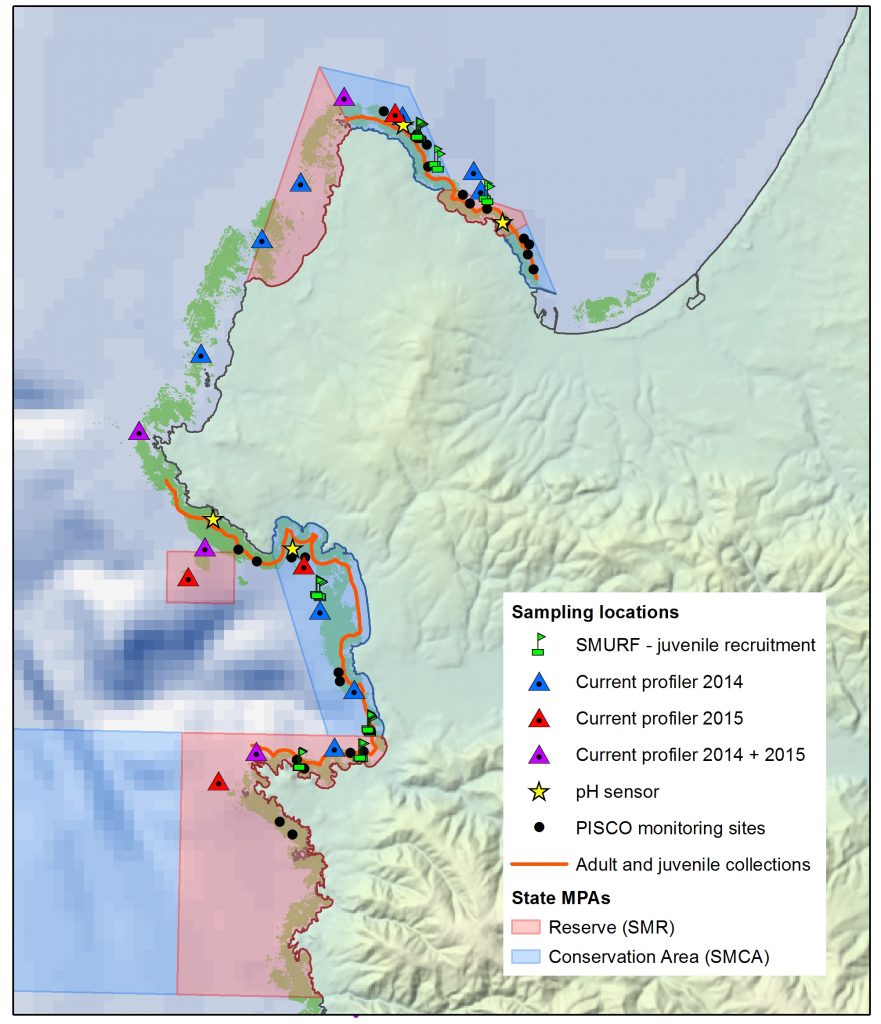Study Site
 We have identified Carmel Bay and the adjacent Monterey Peninsula, located in central California, as an ideal location for this study. It is necessary at this stage of field application of this novel intergenerational tagging method to target an area of potential hydrographic retention to increase the likelihood of recapturing larvae produced by genetically sampled parents.
We have identified Carmel Bay and the adjacent Monterey Peninsula, located in central California, as an ideal location for this study. It is necessary at this stage of field application of this novel intergenerational tagging method to target an area of potential hydrographic retention to increase the likelihood of recapturing larvae produced by genetically sampled parents.
Carmel Bay includes three marine protected areas (MPAs: two marine “reserves” that allow no fishing and one “conservation area” that allows recreational fishing) and nearby areas open to fishing. Southern Monterey Bay includes three MPAs: one no-take “reserve” and two “conservation areas”. Therefore, this study could determine the extent to which larvae produced in the MPAs of Carmel Bay (i) are self-replenishing, (ii) contribute to replenishment of MPAs in southern Monterey Bay, thereby contributing to the MPA network along the central coast, and (iii) contribute to replenishing fished populations in the areas open to recreational and commercial fishing in between these MPAs along the face of the Monterey Peninsula.
Several attributes of Carmel Bay and lines of evidence strongly suggest that larvae produced by genetically sampled adults will recruit both to the southern end of Monterey Bay and within Carmel Bay:
- The semi-enclosed morphology of Carmel Bay, with headlands at the north and south ends, may facilitate retention of larvae produced in the bay by creating retention zones and larval recruitment hot spots, as has been demonstrated previously for other headlands and embayments on the California coast.
- Past ocean current studies using drift cards and plume studies show that surface currents often move inshore from the central section of the bay. Importantly, these drift card studies also indicate that when particles at the surface are transported out of the bay, they typically move northward along the Monterey Peninsula and into and along the southern coast of Monterey Bay, where we propose to focus sampling for kelp rockfish recruits.
- Our preliminary ocean current model, referred to as a Regional Ocean Model (ROMs), predict larval transport from the mouth of Carmel Bay northward and into the southern coastline of Monterey Bay during upwelling relaxation events. Larval retention and onshore larval delivery have been observed in association with upwelling relaxation and downwelling events. The northward transport of larvae during relaxation events may explain observed increases in delivery of kelp rockfish to the southern end of Monterey Bay.
- The existence of a coastal front that establishes at the face of Carmel Bay has been suggested to retain and concentrate larvae there. Recent analyses have identified spatially predictable coastal fronts along the coast from Point Conception to Newport, Oregon that correspond with “hotspots” of onshore delivery and recruitment or larval barnacles or juvenile rockfishes. These fronts are thought to concentrate and retain larvae prior to onshore delivery.